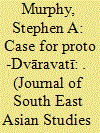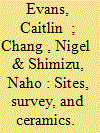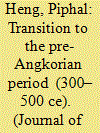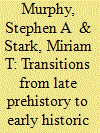|
|
|
Sort Order |
|
|
|
Items / Page
|
|
|
|
|
|
|
| Srl | Item |
| 1 |
ID:
147668


|
|
|
|
|
| Summary/Abstract |
The transition from Late Iron Age to early state societies in the riverine lowlands of the Mun Valley and northern Cambodia took place rapidly in the fifth and sixth centuries CE. Defining the former involves archaeological excavation, whereas the latter is best known from surviving temple structures and inscriptions in addition to the results of archaeological fieldwork. Several common threads link the two phases of cultural development. From the late fifth century BCE, Iron Age communities participated in the growing maritime exchange network linking Southeast Asia with China and India, bringing exotic ideas and goods into the hinterland. Iron itself had a major impact on agriculture and warfare. Salt, a vital commodity that is abundantly available in the Mun Valley, was exploited on an industrial scale. By the fifth century CE, an agricultural revolution involving permanent, probably irrigated, rice fields and ploughing underwrote a rapid rise of social elites. These leaders in society, named in the early historic inscriptions, maintained and elaborated prehistoric innovations.
|
|
|
|
|
|
|
|
|
|
|
|
|
|
|
|
| 2 |
ID:
147666


|
|
|
|
|
| Summary/Abstract |
The mid-first millennium CE represents a crucial period in the emergence of early polities in Southeast Asia. However, disagreement remains between archaeologists and art historians as to the precise dating of this shift from prehistory to history. This article focuses on the Dvāravatī period and re-evaluates evidence in Thai and Western language publications. A growing number of sites excavated over the past two decades in particular show occupation from c. the fourth to fifth century onwards while others provide a continual sequence stretching back well into the Iron Age. I argue that evidence from these sites makes a strong case for postulating a proto-Dvāravatī period spanning c. the fourth to fifth centuries. In doing so this article proposes this period as the timeframe within which the nascent traits and characteristics of what becomes Dvāravatī in the seventh to ninth centuries are present and gradually developing.
|
|
|
|
|
|
|
|
|
|
|
|
|
|
|
|
| 3 |
ID:
147672


|
|
|
|
|
| Summary/Abstract |
Linking the early historic cultures of Southeast Asia to their prehistoric antecedents has, despite some decades of research, proved difficult for a number of reasons. Until the 1960s, this did not seem to be an issue for scholars of the region. For George Coedès, the region was simply occupied by diverse and backward ethnic and linguistic communities, cultivators using stone tools, or at best, people using bronze with poorly developed social organisations until impacted by the expanding Han peoples during the third century CE: ‘There is very little direct information about the societies of South East Asia before they entered into contact with India and China.’
|
|
|
|
|
|
|
|
|
|
|
|
|
|
|
|
| 4 |
ID:
147667


|
|
|
|
|
| Summary/Abstract |
The paradigm that the early Southeast Asian polities known as Dvāravatī and Zhenla were respectively, indeed almost exclusively, Buddhist and Hindu/Brahmanical during the second half of the first millennium CE has long remained uncontested. In this reappraisal, however, arguments are presented that challenge this general scholarly opinion. A thorough reassessment of the material culture and inscriptions from these two neighbouring regions of mainland Southeast Asia tempers such clear-cut compartmentalisation and instead emphasises the complex and evolving nature of the religion of that age through the lens of the ideology of merit. The religious affiliation of certain artefacts and inscriptions that are clearly related to this ideology are further examined and questioned.
|
|
|
|
|
|
|
|
|
|
|
|
|
|
|
|
| 5 |
ID:
147665


|
|
|
|
|
| Summary/Abstract |
This article traces the evolutionary record of urbanism at two sites in Myanmar: their transition from late prehistory in c. second to first century BCE to proto-urban and fully urban development at Sri Ksetra and Beikthano by the mid-first millennium CE. The Pyu cities are remarkable because of their spatial continuity, for their early achievements in water control, iron production, ritual and domestic ceramics, brick monumental architecture, rich funerary culture, literacy and adoption of Buddhism on both elite and popular levels. Though the radiocarbon dates for Pyu urbanism are at present earlier, they share many features with other urbanising societies in mainland Southeast Asia, where new chronologies are emerging for social and economic complexity at Dvaravati, Pre-Angkorian and Co Loa sites. The article provides new and specific evidence on the dates and types of contacts between the Pyu, India, and other areas of Southeast Asia to interrogate the meaning of Indianisation in Southeast Asia.
|
|
|
|
|
|
|
|
|
|
|
|
|
|
|
|
| 6 |
ID:
147670


|
|
|
|
|
| Summary/Abstract |
The understanding of Angkorian pre-state society has been greatly enhanced by an increase in archaeological investigation in recent years. From excavations conducted at Cambodian Iron Age sites we have evidence that attests to a transformative period characterised by increasing sociopolitical complexity, intensified inter- and trans-regional mercantile activity, differential access to resources, social conflict, technological transfer and developments in site morphology. Among the growing corpus of Iron Age sites excavated, Phum Lovea, on the periphery of Angkor, is uniquely placed to provide insight into increasing sociopolitical complexity in this area. The site is one of the few prehistoric moated settlements known in Cambodia and the only one to date to have been excavated. Excavation of the site has revealed an Iron Age agrarian settlement whose occupants engaged in trade and exchange networks, craft specialisation, metal production, and emergent water management strategies. These attributes can be seen as antecedent to the profound developments that characterise the first millennium CE polity centred on Angkor.
|
|
|
|
|
|
|
|
|
|
|
|
|
|
|
|
| 7 |
ID:
147669


|
|
|
|
|
| Summary/Abstract |
Our understanding of the transition from the last centuries of prehistory to the Pre-Angkorian period in northeast Thailand has been limited by a lack of projects bridging both periods. This article examines settlement patterns of the first to the ninth centuries CE in the Upper Mun River Valley based on recent (2012–14) surveys. The findings highlight the gradual settlement trends in the region, with a focus on local modification rather than the sudden adoption of external ideas. Results reinforce the fourth to sixth centuries CE as a pivotal period, when large centres consolidated and cautiously expanded upriver, into previously uninhabited regions. A relatively modest, flexible, and resilient settlement strategy developed, attuned to wider supra-regional trends, but allowing for the demands of the local cultural and physical landscape.
|
|
|
|
|
|
|
|
|
|
|
|
|
|
|
|
| 8 |
ID:
147671


|
|
|
|
|
| Summary/Abstract |
Archaeological data over the past two decades have contributed to our understanding of the transition into the historic period in Southeast Asia and rebutted outdated models of externally stimulated complex polity formation. This article investigates the transition into the Pre-Angkorian period 300–500 CE based on a model constructed using archaeological data from Thala Borivat, Cambodia. Data from Thala Borivat suggest a pattern of continuity where smaller proto-historic settlements may have become incorporated c.300–500 CE into larger ones which became major Pre-Angkorian centres. This phenomenon coincided with evidence of increasing inter- and intra-regional interaction following the proto-historic period. This article argues that the model can be used to reinterpret the pattern observed in major Pre-Angkorian centres in the Mekong Delta and northeast Thailand. This pattern is complemented by the spatial correlation between the chronometrically-anchored ceramic traditions in proto-historic and early historic period Cambodia that suggests the continuity of local communities. Spatial correlation between prehistoric sites and inscriptions recording Pre-Angkorian elites, particularly the poñ, mratāñ, and kings provides similar patterns of continuity between the elites of the late proto-historic to the Pre-Angkorian periods.
|
|
|
|
|
|
|
|
|
|
|
|
|
|
|
|
| 9 |
ID:
147664


|
|
|
|
|
| Summary/Abstract |
Studies of early Southeast Asia focus largely on its ‘classical states’, when rulers and their entourages from Sukhothai and Ayutthaya (Thailand), Angkor (Cambodia), Bagan (Myanmar), Champa and Dai Viet (Vietnam) clashed, conquered, and intermarried one another over an approximately six-century-long quest for legitimacy and political control. Scholarship on Southeast Asia has long held that such transformations were largely a response to outside intervention and external events, or at least that these occurred in interaction with a broader world system in which Southeast Asians played key roles. As research gathered pace on the prehistory of the region over the past five decades or so, it has become increasingly clear that indigenous Southeast Asian cultures grew in sophistication and complexity over the Iron Age in particular. This has led archaeologists to propose much greater agency in regard to the selective adaptation of incoming Indic beliefs and practices than was previously assumed under early scholarship of the nineteenth and early to mid-twentieth century.
|
|
|
|
|
|
|
|
|
|
|
|
|
|
|
|
|
|
|
|
|